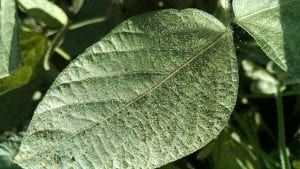Spider Mites Continuing to Build

We have continued to get calls and pictures of soybean fields that are potentially showing signs of spider mite injury in Livingston, Monroe and Wyoming Counties. The hot dry conditions are perfect for their populations to build up. We do have some areas in D2 drought that are probably more vulnerable to mite injury (see map below). Stressed soybeans are more attractive nutritionally and the spider mites seem to reproduce faster and populations bloom. The mites are also more active with the heat and on windy days. They will crawl to the top of the plant and send out a stand of silk into the wind and ride the current wherever it takes them. During drought conditions we normally see the soybeans on the field edge injured first and then you will see yellow spots out in the field from the “ballooning” mites that have started new colonies.
We have the increased chance of rain in the next week so that will help the soybeans recover some. The spider mites are mostly living on the underside of the leaves so the rain, unless really whipping the leaves around, may have minimal affect. The wet conditions do however promote the growth of a fungal pathogen that can quickly reduced mite populations. We also see this happen with soybean aphids. Otherwise, there are a couple of insecticides/miticides that can be sprayed such as Dimethoate, Bifenthrin and Agri-Mek. If mites are heavy, I would not try to spot treat the edges. They have probably already moved to the middle. From my experience, do yourself a favor and spray the whole field.

Considerations for Marestail Control in Wheat Stubble

Riding around the region this week I am seeing a lot of marestail coming up through the wheat stubble. What are you going to do to manage it before it sets seeds? Mowing, tillage, and herbicides alone and in combination are options. Mark Loux of Ohio State has a great article on how to best utilize each of these options.
Goal: control marestail and other weeds, then plant a cover crop. Many growers utilize a cover crop following wheat and other small grains. The major problem with utilizing herbicides prior to cover crop establishment is that 2,4-D, dicamba and Sharpen all have some residual activity and that means delayed planting of cover crops particularly broadleaves (clover, radish, turnip) for 30 days or more. Planting annual ryegrass, oats or cereal rye would be a safer bet with these products. We like to get our cover crops planted during the first two weeks of August. That’s right now! Products such as Gramoxone and Glufosinate have no soil activity and so no waiting period to plant any cover crop and could be options for immediately planting broadleaves. However, there is no silver bullet here. Mark Loux has a Part 2 article that further explains the pros and cons of each of these burndown options.


